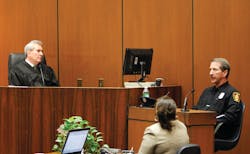EMS: Firefighter/Paramedics Front and Center in Jackson Case
One thing is for sure in EMS – whenever you start your shift, you do not know what the day (or night) is going to bring. You don’t know what calls you will be dispatched to and you certainly don’t know what you will encounter during your shift.
That was probably the case for Martin Blount and Richard Senneff, both firefighter/paramedics assigned to Rescue Ambulance 71 with the Los Angeles Fire Department on June 25, 2009. Both firefighter/paramedics and Engine 71, with a captain, engineer and two other firefighter/paramedics, were dispatched on June 25, 2009to Michael Jackson’s house.
On Sept. 30, 2011, Blount and Senneff were called into court to testify in Dr. Conrad Murray’s manslaughter trial. Murray is charged with manslaughter and accused of administering a lethal dose of the powerful anesthetic propofol to Jackson on that June day in 2009.
The appearance of Blount and Senneff in the courtroom supports the point that proper documentation is essential for all calls. During his courtroom appearance, Senneff was asked to describe his role on that call. On that particular day, Senneff was riding in the passenger seat of the ambulance and he said that made him the medical team leader, so he handled the radio and all communications and wrote all the reports.
During the opening line of questioning, an image of the teletype received in the station when the alarm was dispatched was projected in the courtroom. During his testimony, Senneff had to walk the jury through the document, line by line describing what each line meant. The alarm was received in the Alarm Office at 1221 hours, the station received the dispatch at 1222 hours and the responders arrived at the home at 1226 hours. The teletype also indicated the call was for a cardiac arrest of a 50 year-old male.
Under further questioning, Senneff indicated he found Jackson down in a bedroom in pajamas and the only people in the room were Murray and a security guard. He said he asked the doctor several times whether there was a DNR and that he observed an IV stand with an IV bag hanging from it. Senneff also indicated Murray appeared to be frantic. According to Senneff’s testimony, Murray did not tell paramedics on scene that Jackson had propofol in his system, but instead told them the performer had been given no medication. Murray later admitted he had given Jackson the sedative Lorazepam. Despite the fact that Jackson had died, Senneff told the jury, he tried to resuscitate the singer for approximately 47 minutes, noting Murray refused to let them officially declare Jackson dead.
During his testimony, Blount said he saw three open bottles of lidocaine on the floor of the room, but Murray never mentioned giving Jackson the painkiller. Blount told jurors he saw the doctor scoop up the vials and drop them into a black bag. While in the ambulance, Blount said, he heard Murray make a cell phone call. Blount testified that he remembers hearing Murray say, “It’s about Michael and it doesn’t look good.”
Being called into a courtroom to testify is not uncommon for firefighter/paramedics. Work long enough in this profession and eventually you will be subpoenaed to court. In this case, Blount and Senneff were testifying in a criminal matter, but it is not unusual for paramedics to be subpoenaed to testify in civil matters in which one party is suing another, usually in cases of injury.
In all comes down to documentation. In this case, Blount and Senneff were testifying more than two years after the incident occurred. Most of us cannot even remember what we had for breakfast yesterday, let alone something that happened more than two years ago. It’s likely that Blount and Senneff remembered many of the details of the Michael Jackson cardiac arrest because it was such a high-profile event, but if the call had involved an ordinary citizen, chances are they would have not remembered the call. All that would have given them the ability to testify with such accuracy would have been the documentation they had on their patient-care report.
Over the years, I have had the opportunity to perform expert-witness work for attorneys. Many times, I have been appalled by the documentation or the lack of documentation by paramedics. In some cases, the proliferation of electronic documentation has made the situation worse. Unless a paramedic is familiar with the software, it either defaults to an empty box or the paramedic hastily goes through and clicks the wrong information without double-checking the work.
I wish I knew how the law enforcement profession gets police officers to write such detailed reports, since I have never seen a poorly written police report. Police officers consistently provide very comprehensive and specific details in their reports. To the contrary, paramedics can be very poor at documenting medical encounters and, unfortunately, it can come back to haunt them since in the legal arena, if it is not documented, it was not done.
Chances are one day, you will find yourself sitting in a courtroom or at a deposition testifying or unfortunately the defendant on a lawsuit and you will have to explain your actions. With proper documentation, you will be able to testify with ease.
